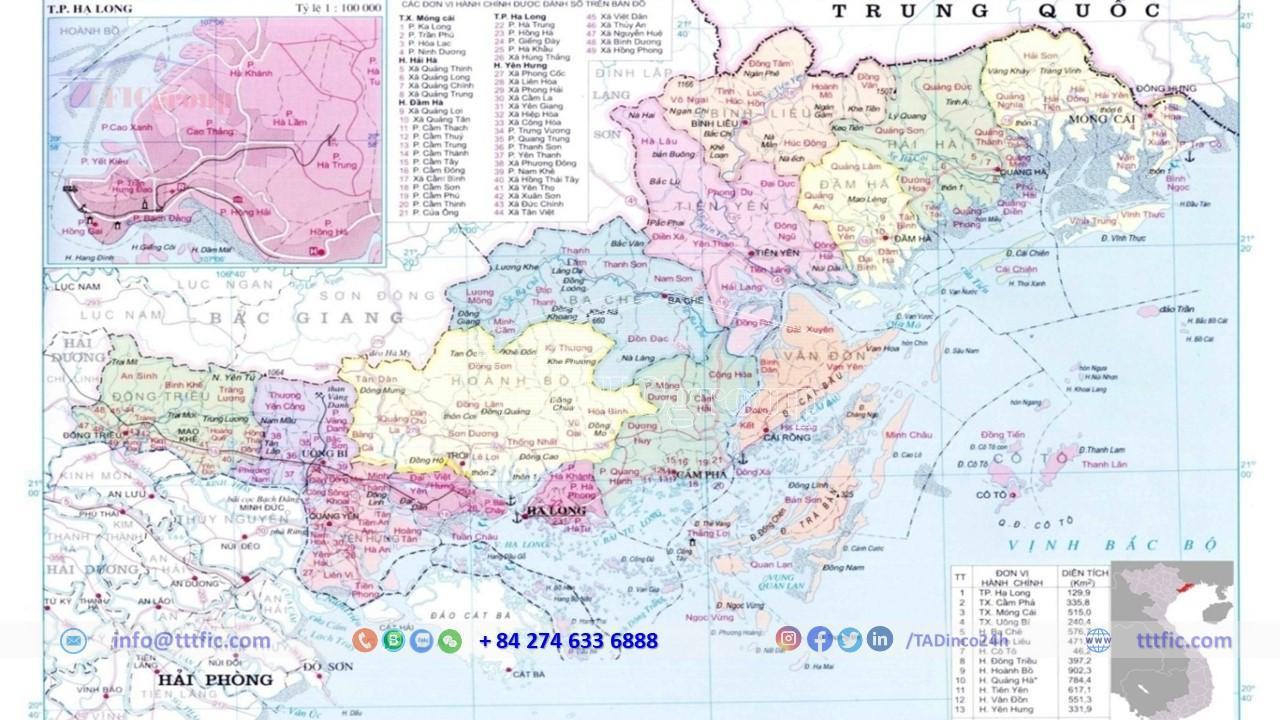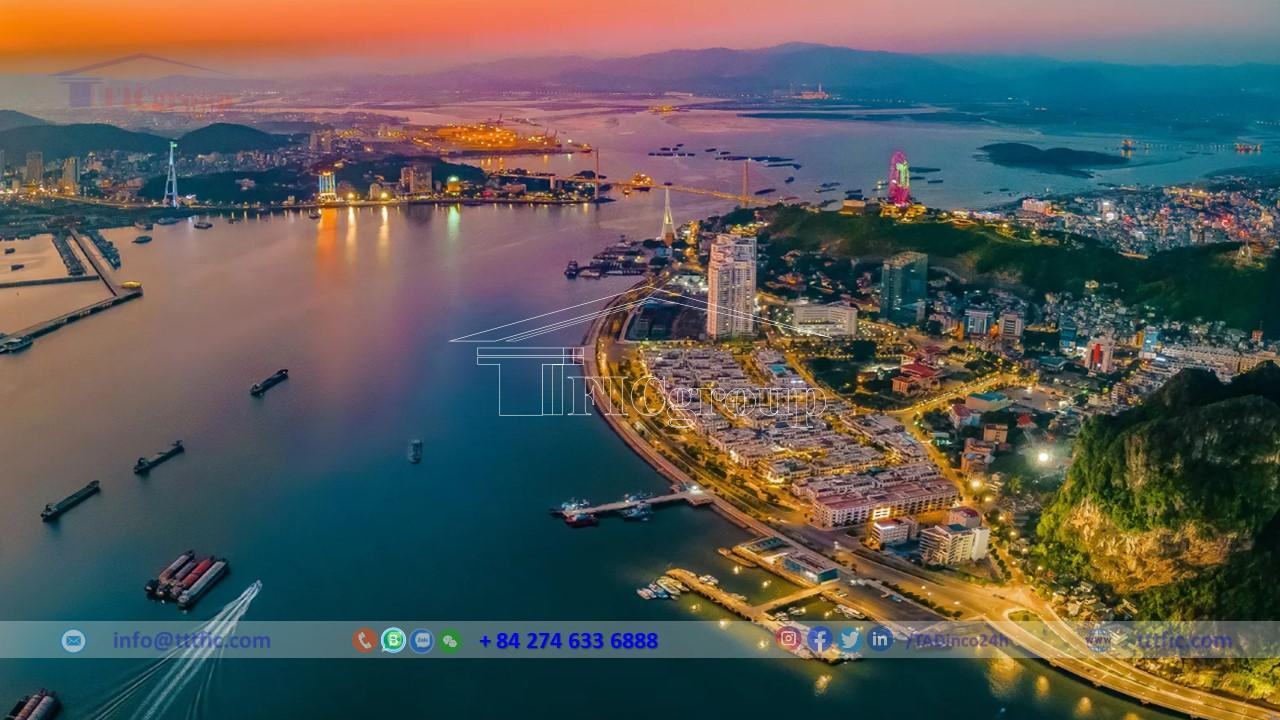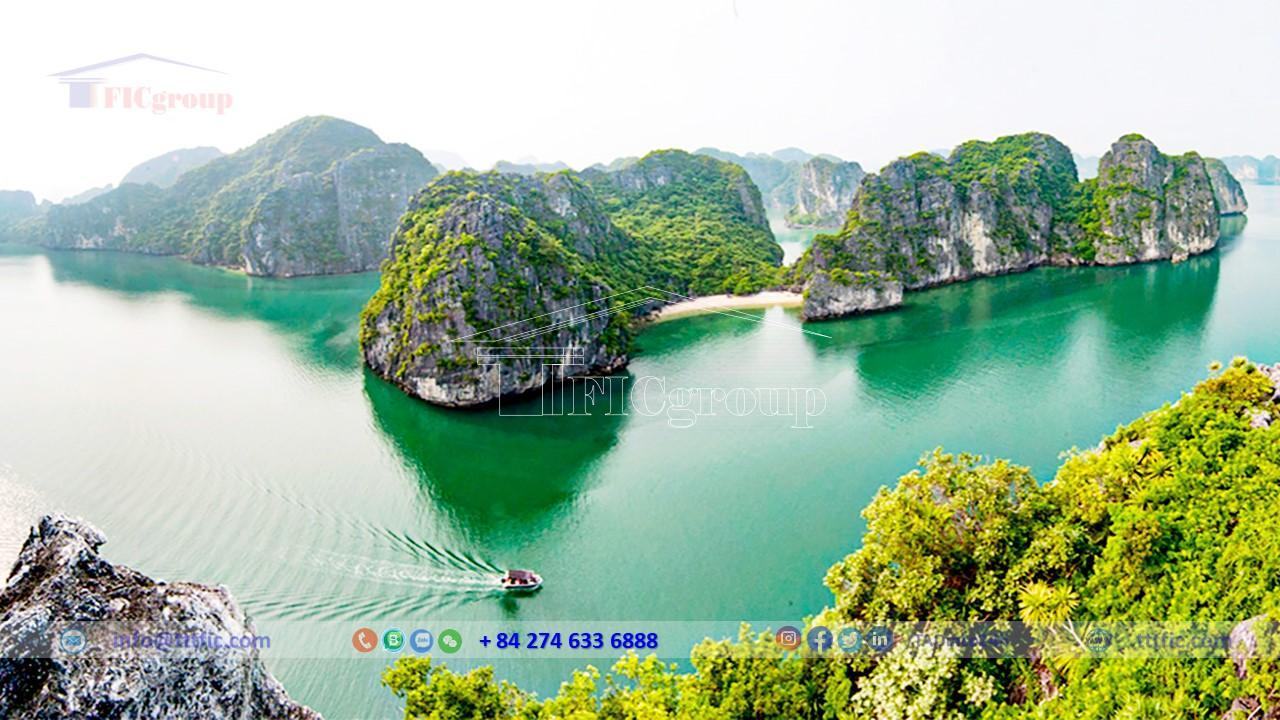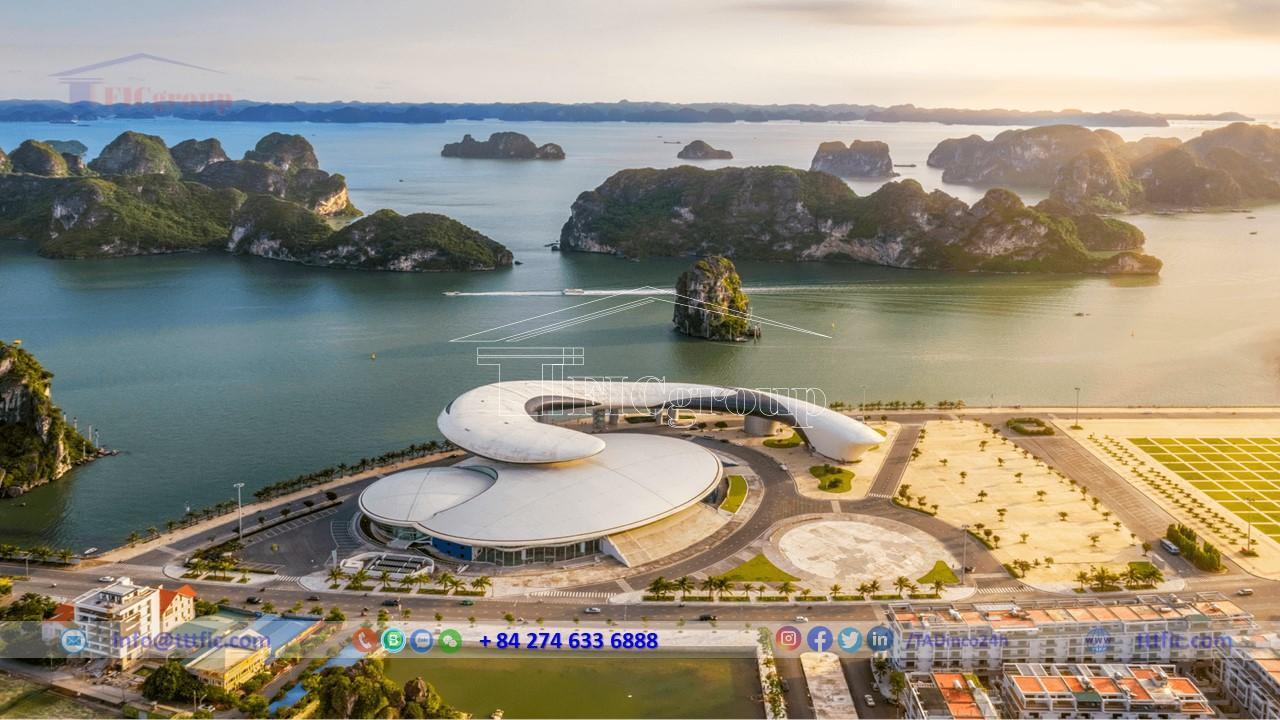Quang Ninh Province:
Quang Ninh province is located in northern Vietnam. In 2019, it had an area of approximately 6,178.2 km² and a population of over 1,324,800 people. Quảng Ninh is renowned for Hạ Long Bay, a UNESCO World Heritage Site. Hạ Long Bay is a popular tourist destination with its stunning limestone islands, magnificent caves, and breathtaking landscapes.
In addition to Hạ Long Bay, Quảng Ninh boasts many other tourist attractions that attract visitors, such as Tuần Châu Island, Bãi Cháy Bridge, Suối Moóc tourist area, Cửa Ông Temple, Hạ Long Night Market, and numerous beautiful beaches.
The province’s economy relies primarily on tourism, coal mining, and heavy industries. It is also home to Cái Lân Port, one of Vietnam’s important seaports.
Quảng Ninh is also a venue for significant cultural and sporting events, including the Quảng Ninh Festival, the International Ha Long Bay Sailing Race, and the Ha Long Carnival.
In summary, Quảng Ninh is a famous tourist destination with Hạ Long Bay and has a developed economy based on tourism, coal mining, and heavy industries.

Geography of Quang Ninh Province:
Geographical location:
Quảng Ninh province is situated in the northeastern part of Vietnam, extending from northeast to southwest. It is located 125 km east of the capital city, Hanoi.
Quảng Ninh shares borders with various regions:
- To the north, it borders the Choang Quảng Tây Autonomous Region in China.
- To the east and south, it borders the Gulf of Tonkin.
- To the southwest, it borders Hải Dương province and Hải Phòng city.
- To the northwest, it borders Bắc Giang province and Lạng Sơn province.
Quảng Ninh has several extreme points within its territory:
- The easternmost point on the mainland is at Gót Cape, Trà Cổ Ward, Móng Cái city.
- The easternmost point in the sea is at Sa Vĩ Cape.
- The westernmost point is in Thôn 1, Nguyễn Huệ Commune, Đông Triều town.
- The southernmost point is on Hạ Mai Island, Ngọc Vừng Commune, Vân Đồn district.
- The northernmost point is at Mỏ Toòng Hamlet, Hoành Mô Commune, Bình Liêu district.
This province is one of the seven provinces in Vietnam that shares a border with China, but it is the only province with both land and sea borders with China.
Topographic:
Located in northeastern Vietnam, Quảng Ninh province combines mountains and coastlines, with 80% of its land covered by hills and mountains. It boasts over 2,000 unnamed limestone islands along its shores, scattered in the sea.
The province’s topography consists of three regions: the mountainous region, the midland and coastal plain region, and the coastal and island region. The mountainous region is divided into two sections: the eastern region from Tiên Yên to Móng Cái and the western region from Tiên Yên to Đông Triều.
The midland and coastal plain region includes gentle hills, fertile plains, and tidal flats, providing favorable conditions for agriculture and transportation. It encompasses districts like Đồng Rui, Uông Bí, Quảng Yên, Đầm Hà, and Móng Cái.
Quảng Ninh’s coastal and island region stands out with more than 2,000 islands, accounting for two-thirds of the country’s total. These islands stretch over 250 kilometers along the coastline, varying in size and shape. Notable islands, such as Cái Bầu and Bản Sen, dot the landscape. Hạ Long Bay and Bái Tử Long Bay, famous for their limestone karst formations, feature stunning caves and breathtaking scenery. The region also offers picturesque sandy beaches like Trà Cổ, Quan Lạn, Minh Châu, and Ngọc Vừng.
The seabed of Quảng Ninh displays uneven topography, with an average depth of 20 meters. Deep channels and submerged rock formations provide habitats for diverse coral reefs. The flowing currents connect with deep channels, establishing an extensive network of waterways and harbors, making Quảng Ninh a significant maritime and transportation hub.
Overall, Quảng Ninh province entices visitors with its diverse and scenic landscape, encompassing mountains, plains, islands, and coastal areas. Its abundant natural resources and tourism opportunities make it an extraordinary destination.

Climate:
Quảng Ninh province in northern Vietnam has a distinct climate with hot and humid summers and cold and dry winters. It is heavily influenced by the Northeast monsoon and experiences two solar zenith passages annually. Coastal islands have a maritime climate with a hot and humid summer and a cold and dry winter. The average humidity is 82-85%. The cold season lasts from mid-November to March, while the hot season begins in May. Quảng Ninh has a cool and mild climate due to its proximity to the sea, making it suitable for agriculture. The average annual temperature is 21-23 degrees Celsius, with variations between seasons and areas. Some parts experience salt fog and occasional snowfall in December and January.
The province receives significant rainfall, mainly in the summer, accounting for 85% of the annual total. The average annual rainfall is 1,995mm, with variations across different regions. The summer monsoon brings heavy rainfall from May to October, accompanied by typhoons and tropical low-pressure systems. Quảng Ninh experiences 5-6 typhoons on average each year. The winter monsoon from November to April brings cold and dry weather.
Natural resource:
Land resources:
Quảng Ninh, a province in Vietnam, boasts diverse land resources. Agricultural land accounts for 10%, while forested land covers 38%. The unused land is primarily concentrated in mountainous and coastal areas. Quảng Ninh benefits from its favorable topography and climate for timber and resinous trees. The prevalent types of land in low-lying hills are red-yellow feralit and secondary grassy feralit. Along Highway 18, there is alluvial soil, while coastal and river areas have saline land. Coastal and island regions are characterized by sandy and dune land. Limestone hills dominate the islands and archipelagos.
Forest resources:
In Quảng Ninh, Vietnam, the total forest and woodland area is 243,833.2 hectares, accounting for 38% of the province’s natural land. Natural forests make up approximately 80%, while the remaining area consists of planted forests and specialty forests, spanning around 100,000 hectares. There are also approximately 230,000 hectares of land that have transformed into forest, providing favorable conditions for the development of agricultural areas and large-scale cultivation of specialty crops and fruit trees.
Marine resources:
Quảng Ninh possesses great strengths and enormous potential for developing its maritime economy. It boasts the second longest coastline in Vietnam, stretching 250 km and encompassing 2,077 islands, which account for two-thirds of the country’s total islands, with over 1,000 of them named. The province also encompasses a vast fishing ground of over 6,100 km², serving as a habitat for numerous rare marine species.
Most major fishing grounds in Quảng Ninh have high and stable yields, conveniently located near the coast and around the islands, facilitating exploitation. The coastal areas of Quảng Ninh feature deep waters and favorable wind conditions, providing a crucial advantage for the construction and development of an extensive port system, including deep-water ports capable of accommodating large-tonnage vessels, as well as inland water ports. Notably, this advantage is particularly significant in Hạ Long City, Cẩm Phả City, Tiên Yên District, Móng Cái City, and Hải Hà District, facilitating the exchange of goods with other provinces in the region.

The economic situation in Quang Ninh province is currently experiencing significant and positive development. Here is a detailed analysis of its economic situation:
Coastal Economy:
Quang Ninh enjoys a strategic geographical position with its long coastline and numerous islands. This provides a foundation for the development of coastal economic sectors such as marine tourism, aquaculture, logistics, and maritime transport. The seaports of Ha Long and Cai Lan play a crucial role in facilitating trade and promoting exports.
Tourism:
With world-renowned landscapes like Ha Long Bay – a UNESCO World Heritage site, Quang Ninh is an attractive tourist destination, attracting a large number of domestic and international visitors. The tourism industry plays a vital role in the province’s economy, generating income for local residents and contributing to its overall development.
Industrial Development:
Quang Ninh is actively promoting the growth of processing, manufacturing, and construction industries. Several industrial zones have been established, attracting investments and creating employment opportunities for the local workforce. Industries such as rubber processing, timber, aquaculture, and agricultural products make significant contributions to production and exports.
Agriculture:
Despite the emphasis on industrial development, agriculture continues to play a crucial role in Quang Ninh’s economy. The province has a significant agricultural land area and focuses on cultivating specialty crops such as pepper, guava, dragon fruit, and vegetables.
Transportation:
Quang Ninh is upgrading and expanding its transportation infrastructure to facilitate mobility and economic growth. The completion of the Ha Long – Hai Phong Expressway has improved connectivity with neighboring provinces and key economic areas like Hai Phong and Hanoi.
In summary, Quang Ninh is witnessing economic diversification across various sectors, including coastal economy, tourism, industry, and agriculture. These sectors hold great potential for development and contribute to the province’s economic growth.
Social:
Residential:
In 2019, the population of Quang Ninh province reached 1,324,800 people, with an area of 6,178.2 km², resulting in a population density of 214 people/km². Among them, the urban population was 853,700 people, accounting for 64.4% of the total population of the province. Quang Ninh is currently one of the most urbanized areas in Vietnam, surpassing even the capital city of Hanoi. In Quang Ninh, the male population is higher than the female population. It is also the province with the highest male-to-female sex ratio in comparison to the Red River Delta region, with 103.5 males for every 100 females.

Religion:
Quang Ninh, a region with rich cultural heritage, has its profound impact on the evolution of the Vietnamese people. The inhabitants of Quang Ninh hold their religious and spiritual beliefs:
Buddhism has a long history in this land. Even before King Tran Thai Tong (1225-1258) embraced Buddhism on Yen Tu Mountain, numerous practitioners had already dedicated themselves to the faith. King Tran Nhan Tong (1279-1293) chose Yen Tu as a significant site for monastic practice and introduced the Truc Lam Zen sect in Vietnam. During the 14th century, Yen Tu and Quynh Lam (Dong Trieu) emerged as significant hubs of Buddhism, where the training of monks and nuns took place, catering to the spiritual needs of the entire nation.. Through the centuries, Buddhism flourished, and Quang Ninh boasts hundreds of temples, including renowned ones like Loi Am Pagoda, Long Tien Pagoda (Ha Long), Cai Bau Pagoda (Van Don), Linh Khanh Pagoda (Tra Co – Mong Cai), Ba Vang Pagoda (Uong Bi), Ho Thien Pagoda (Dong Trieu), Linh Quang Pagoda (Quan Lan)…
Though not as numerous as Buddhist followers, other religions also have their adherents. As of April 1, 2019, Quang Ninh province counted 89,455 followers across six different religions. Catholicism had the largest number with 44,330 followers, encompassing 27 Catholic churches spread across 9 parishes and 41 denominations in 8 districts, towns, and cities. Buddhism had 44,278 followers, followed by Protestantism with 552 followers, Caodaism with 87 followers, Islam with seven followers, and Tinh Do Cu Si Buddhist Association of Vietnam with only one follower. The prevalent beliefs among the residents of Quang Ninh include ancestral worship, veneration of military leaders from the Tran dynasty, reverence for deities such as Thanh Hoang, mountain and water deities, and the worship of goddesses like Mau Lieu Hanh, Mau Thuong Ngan, and Mau Thoai.
Healthcare:
Quang Ninh has invested in a well-developed healthcare infrastructure to meet the medical needs of its residents and tourists from both domestic and international backgrounds. As of 2010, the entire province of Quang Ninh had 15 hospitals, 9 regional polyclinics, 10 provincial medical centers, 14 district medical centers, and 186 commune health stations. The healthcare workforce consists of highly professional personnel, including 2 medical doctors with Ph.D. degrees, 53 medical doctors with Master’s degrees, 24 specialists with a level II qualification, 218 specialists with a level I qualification, 437 medical doctors, 478 nurses, 109 technicians, 960 nursing staff, 225 midwives, 43 university-level pharmacists, 99 high school-level pharmacists, and 982 other specialized professionals. By 2015, the province achieved a ratio of 42.3 hospital beds per 10,000 population, nearly double the national average, and a ratio of 12.26 medical doctors per 10,000 population, surpassing the national average by approximately 1.6 times.
The preventive healthcare capacity of Quang Ninh’s healthcare system ranks among the top in the country. National target programs related to healthcare, food safety and hygiene, family planning, and HIV/AIDS prevention and control have been effectively implemented. The province has essentially achieved the goal of meeting the National Criteria for Commune-level Healthcare during the 2011-2020 period, reaching the target 5 years ahead of the Ministry of Health’s regulations.







